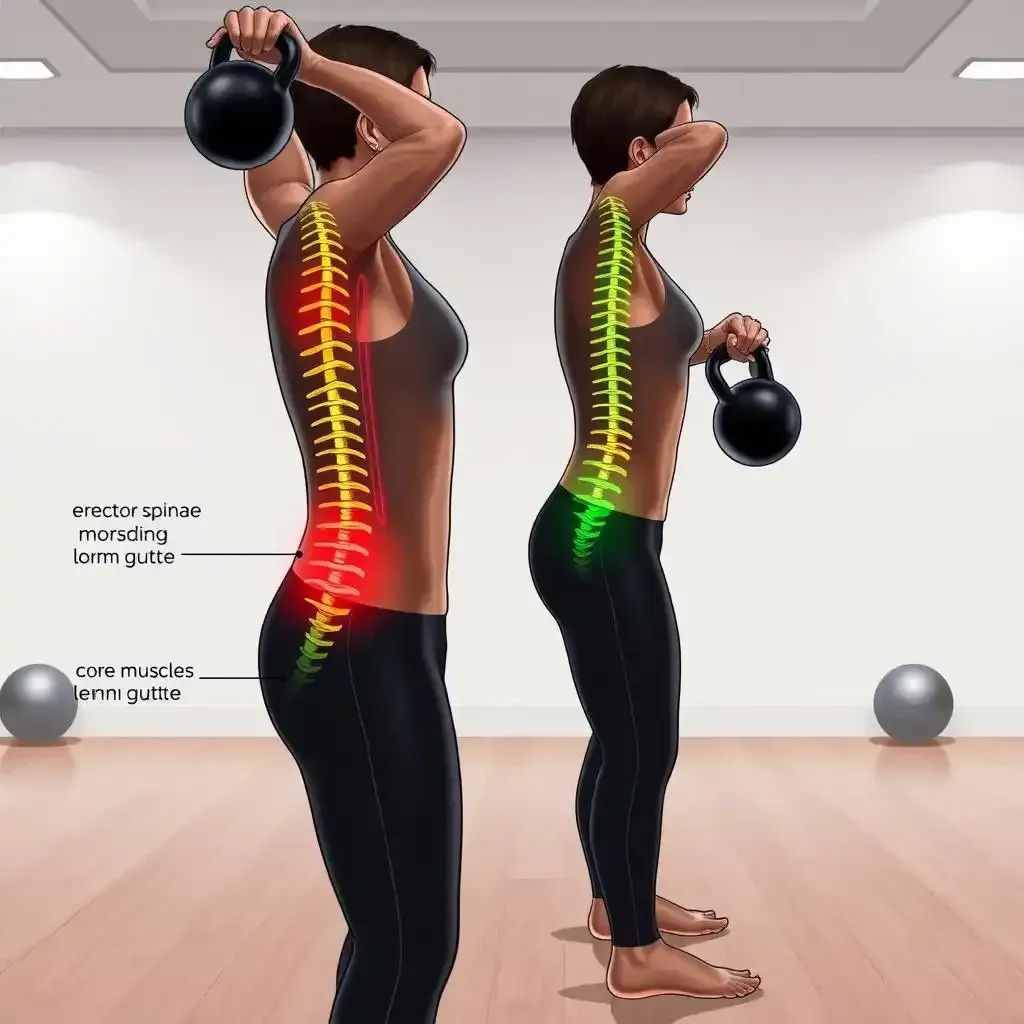Table of Contents
Do you spend most of your day sitting at a desk? Do you often feel hunched over and struggle with back pain? You're not alone. Poor posture is a common problem, but the good news is that kettlebell workouts can significantly improve your posture. In this article, we'll explore how kettlebell exercises, especially the kettlebell swing, can strengthen your postural muscles, improve spinal alignment, counter the effects of sitting, and enhance shoulder stability. Whether you're a fitness enthusiast or just starting out, this guide from kettlebellworkout.homes will give you the insights you need to stand taller and feel better. So, let’s examine in!
Kettlebell Posture Benefits: Strengthening Your Back

Kettlebell Posture Benefits Strengthening Your Back
How Kettlebells Improve Your Posture
Kettlebell exercises are a fantastic way to improve your posture. When you swing a kettlebell, you engage your entire back, from your upper back to your lower back and hips. This helps to strengthen the muscles that keep you upright and encourages good posture. By incorporating kettlebell swings into your workout routine, you can improve your posture and reduce back pain. Kettlebell Exercises for a Stronger Back
Good posture isn't just about looking better; it's also about feeling better. When you have good posture, you're less likely to experience back pain and fatigue. Plus, good posture can even improve your breathing and digestion. So, if you're looking for a way to improve your overall health and wellbeing, consider adding kettlebell swings to your workout routine.
Benefit | Description |
|---|---|
Improved Posture | Kettlebell swings strengthen the muscles that keep you upright, improving your posture and reducing back pain. |
Reduced Back Pain | By strengthening the muscles in your back, kettlebell swings can help reduce back pain and fatigue. |
In addition to improving your posture, kettlebell swings can also help improve your balance and coordination. By engaging your entire back and hips, kettlebell swings challenge your balance and help improve your overall stability. This can be especially beneficial for athletes or individuals who participate in activities that require good balance and coordination.
So, how can you incorporate kettlebell swings into your workout routine? Here are a few tips to get you started:
- Start with a light weight: Begin with a light weight and gradually increase the weight as you become more comfortable with the swing.
- Focus on form: Pay attention to your form and make sure you're swinging the kettlebell with your hips and back, rather than just your arms.
- Practice regularly: Practice kettlebell swings regularly to see improvement in your posture and overall fitness.
By incorporating kettlebell swings into your workout routine, you can improve your posture, reduce back pain, and improve your overall fitness. So, why not give it a try? Grab a kettlebell and start swinging your way to better posture today!
How Kettlebells Improve Spinal Alignment

How Kettlebells Improve Spinal Alignment
Okay, so visualize this: your spine's like a really cool, flexible skyscraper. It needs strong support to stand tall and proud, right? That's where those amazing back muscles come in – they're the steel beams holding everything up. When you slouch, it's like those beams are all bent out of shape. But kettlebell exercises? They're like a team of construction workers, carefully reinforcing those beams, one swing at a time!
Kettlebell swings, especially, are awesome for this. They really work those erector spinae muscles – the main support crew for your spine. Think of them as your spine's personal bodyguards. These muscles run along your back, from your neck all the way down to your lower back. Strengthening them with kettlebell swings helps keep your spine perfectly aligned, preventing that annoying hunch and promoting a healthier, more balanced posture. It's like giving your spine a super-powered hug, keeping it straight and strong. For more tips on building a strong back, check out these .
Muscle Group | Role in Spinal Alignment | How Kettlebells Help |
|---|---|---|
Erector Spinae | Main support for the spine | Strengthened through dynamic movements like the kettlebell swing |
Glutes | Provide stability and support | Activated during the hip hinge motion of the swing |
Core Muscles | Maintain spinal stability | Engaged to control the movement and prevent injury |
I remember when I first started, my posture was terrible. I was all hunched over like a question mark! But after a few weeks of consistent kettlebell swings, I noticed a huge difference. My back felt stronger, and I naturally stood taller. It was pretty cool seeing that improvement! To start your kettlebell trip, check out our beginner kettlebell guide for a smooth start.
One thing to remember is that consistency is key. Just like building a skyscraper takes time, building strong back muscles takes time too. Don't expect miracles overnight. Start slowly, focus on proper form, and gradually increase the weight as you get stronger. Before you know it, you'll be standing tall and proud, with a spine as straight as an arrow – or at least, straighter than before!
- Start with lighter kettlebells.
- Focus on proper form – your spine should be neutral.
- Gradually increase weight and reps as you get stronger.
And hey, don't forget to listen to your body. If something feels wrong, stop and rest. Proper form is way more important than lifting heavy weights. Think of it like this: a wobbly skyscraper is a dangerous skyscraper! Check out our kettlebell safety tips for a safe and effective training session.
Countering the Effects of Sitting with Kettlebells

Countering The Effects Of Sitting With Kettlebells
How Sitting Affects Your Posture
Sitting for long periods can be a real pain in the neck—or back, to be more precise. When you're glued to a desk, your muscles can tighten up, and your posture can suffer. Think about it: hunched over your computer, shoulders rounded, and your back curved. It's a recipe for disaster, leading to chronic pain and poor posture.
But there's good news! Kettlebell exercises can help counteract these effects. Just like a superhero swooping in to save the day, kettlebells can strengthen your postural muscles and help you stand tall and proud. They engage your back, core, and legs, all of which play a crucial role in maintaining good posture. For a beginner's guide to kettlebells, check out our .
- Engages back muscles
- Strengthens core
- Improves leg stability
Getting Started with Kettlebell Posture Exercises
Now that you know how kettlebells can help, let's investigate into some practical tips. First, start with a light kettlebell. You don't want to overdo it, especially if you're new to kettlebell training. A 10 to 15-pound kettlebell should do the trick for most beginners. As you get more comfortable, you can gradually increase the weight.
One of the best kettlebell exercises for posture is the kettlebell swing. It's like a full-body workout wrapped up in one move. Here’s how to do it:
- Stand with your feet shoulder-width apart.
- Hold the kettlebell with both hands in front of you.
- Hinge at your hips and swing the kettlebell back between your legs.
- Then, drive your hips forward and swing the kettlebell up to shoulder height.
- Control the kettlebell as it swings back down and repeat.
Exercise | Description | Benefit |
|---|---|---|
Kettlebell Swing | Swing the kettlebell back between your legs and up to shoulder height. | Strengthens back, core, and legs. |
Deadlift | Lift the kettlebell from the floor to a standing position. | Builds strong back and legs. |
Goblet Squat | Squat while holding the kettlebell close to your chest. | Improves leg and core strength. |
Another great exercise is the deadlift. It's a simple yet effective move that targets your back and legs. Stand with your feet shoulder-width apart, hold the kettlebell in front of you, and lower it to the ground by hinging at your hips. Then, lift it back up to the starting position. This exercise helps strengthen your back and legs, which are essential for maintaining good posture.
If you're new to kettlebell training, it's important to focus on proper form. Don't rush into heavy weights or complex movements. Start with basic exercises and gradually work your way up. For more tips on getting started, visit our kettlebell exercises starter guide.
Enhancing Shoulder Stability and Reducing Muscle Imbalances
Let's talk shoulders! Think of your shoulders like the perfectly balanced wheels of a bicycle. They need to spin smoothly and evenly to keep you moving forward without wobbling. But, if you spend all day hunched over, one side of your shoulder might be stronger than the other. It's like having one bicycle wheel bigger than the other – not a good recipe for stability! That's where kettlebells come in handy.
Kettlebell exercises, especially those that involve a lot of pulling and pressing motions, help even out those imbalances. They work all the muscles surrounding your shoulder joint. It's like giving your shoulders a really thorough workout, making sure everything's strong and supportive. This helps to improve your posture, reduce pain and improve overall strength. For more on beginner kettlebell routines, check out our beginner routines.
- Kettlebell swings work your back, which helps balance out your chest muscles.
- Kettlebell presses target your shoulders and triceps, building even strength.
- Kettlebell rows strengthen your back, improving posture and stability.
I used to have really bad shoulder pain from sitting at my desk all day. My right shoulder was way tighter than my left, and it really affected my posture. After a few weeks of incorporating kettlebell exercises into my routine, I noticed a significant improvement. My shoulders felt more balanced, and my posture became much better. It was like magic! For simple kettlebell exercises, try our simple exercises guide.
Remember, it's all about consistency. Just like building a strong house takes time and effort, building strong, balanced shoulders requires regular practice. Start slowly, focus on proper form, and gradually increase the weight as you get stronger. If you're ever unsure about your form, it's always a good idea to consult a qualified fitness professional. Our can help you avoid injuries.
Exercise | Muscle Groups Worked | Benefits for Shoulder Stability |
|---|---|---|
Kettlebell Swings | Back, shoulders, core | Improves overall stability |
Kettlebell Presses | Shoulders, triceps | Builds strength and balance |
Kettlebell Rows | Back, biceps | Counteracts muscle imbalances |
One more thing: listen to your body! If you feel any pain, stop immediately. It's way better to take a break than to push through pain and risk injury. Remember, building strength is a marathon, not a sprint. It's all about slow and steady progress. For a guide on choosing the right kettlebell weight, check out our kettlebell weight guide.
So there you have it! With kettlebells, you can build a strong, balanced, and injury-resistant body. It's not just about looking good, it's about feeling good too. And remember, even small steps can lead to big changes. Start today, and you'll be amazed at the difference!
Final Thought
Incorporating kettlebell exercises into your routine can have a profound impact on your posture. From strengthening the muscles that keep you upright to counteracting the negative effects of a sedentary lifestyle, kettlebells offer a versatile and effective way to improve your overall well-being. Remember, good posture isn't just about looking better; it's about feeling better and reducing the risk of chronic pain. So, grab a kettlebell and start swinging today. Your back will thank you!